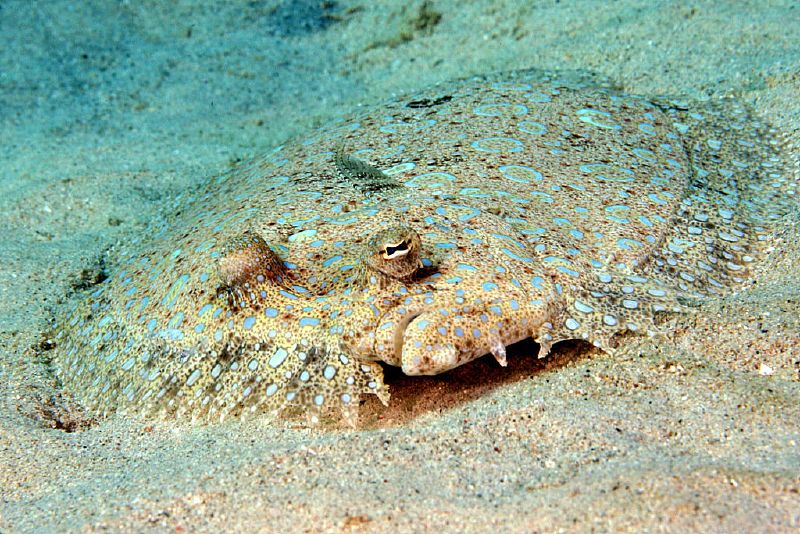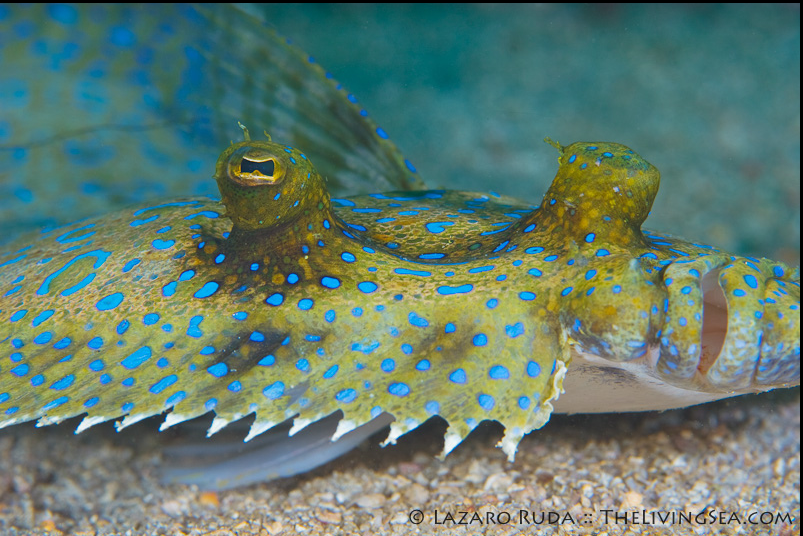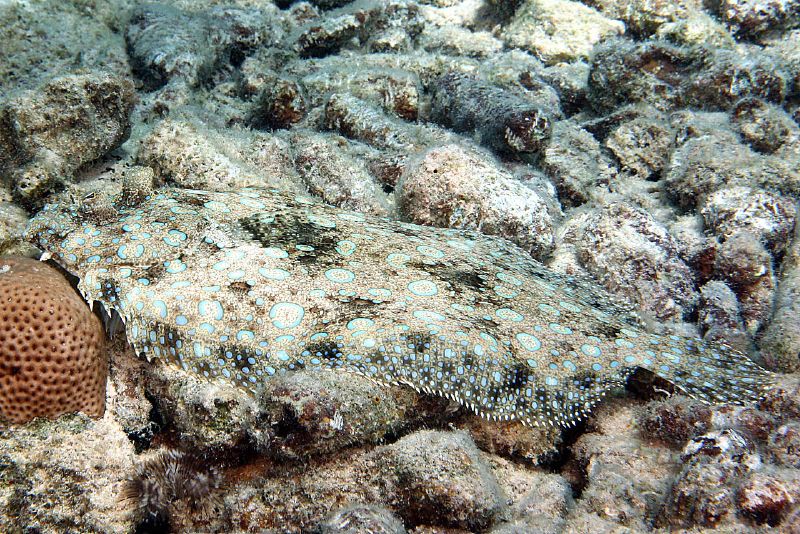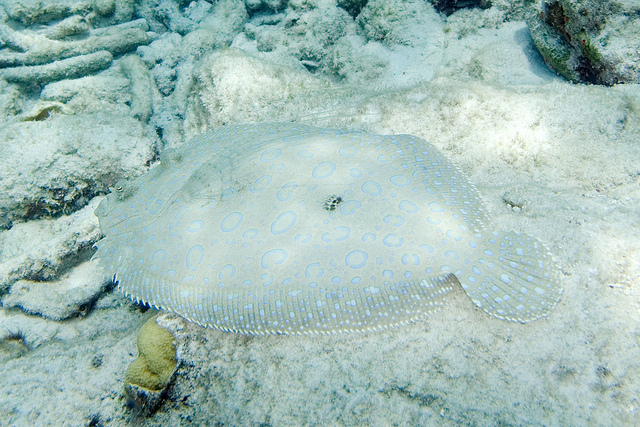Form and Function
The Peacock Flounder is a very unique looking fish. It has a
disk-shaped, laterally compressed body that can be found in
other many other flatfish such as the
Winter Flounder. Its body is ringed almost
entirely by the dorsal and anal fins, while the pectoral fin is
long and often erect (Florida Museum of Natural History 2013,
Marine Specied Identification Portal 2014). The maximum length it can reach is 45cm
(Miller et al. 1991). Both eyes are on one side, making the
flounder completely blind on the other side. This body form is
beneficial for the flounder in several ways. First, it allows
the flounder to partially bury itself in sandy bottoms with its
blind side underneath. From this position, the flounder can
safely survey the ocean floor around it, ready to ambush any
prey that comes its way (Florida Museum of Natural History
2013).

Here you can see the flat body shape of B. lunatus and how this form aids the flounder in partially burying itself in the sand.
The Peacock Flounder has unique eyes, which are relatively large and poised on short, thick stalks on the left side of the flounder’s body. There is a wide space between the two eyes and the lower eye protrudes further forward (Florida Museum of Natural History 2013; Marine Species Identification Portal 2014). Additionally, each eye has the ability to move on its own, independent from the other eye. These unique eye structures are advantageous for the flounder in several ways. Since they are raised on stalks, they give the flounder a good view of the ocean floor. Additionally, their ability to move independently from one another allows the flounder to constantly search its surroundings for potential predators and scope out food (Shedd Aquarium 2006). The eyes come to be on the left side of the flounder in a very interesting manner. Early in the larval stage, B. lunatus has one eye on each side of its head. However, during a period of body transformation called metamorphosis, the dorsal fin becomes detached from the head and opens a slit through which the right eye moves to the left side (Evseenko 2008). If you would like to learn more about the metamorphosis process check out the reproduction and early life history page.
The position of the flounder's eyes enable it to easily scope the ocean floor for food or predators.
This photograph depicts the metamorphosis stage of the larval flounder, in which the right eye migrates through a slit over to the left side. This process is how both eyes of the flounder come to be on the same side. It is described in more detail on the reproduction and early life history page.
One especially unique characteristic of B. lunatus is its coloration and ability to camouflage with the bottom substrate. The flounder’s bottom side is a uniform tan color, while the top side ranges in shades of grey, to brown, to tan (Florida Museum of Natural History 2013; Shedd Aquarium 2006). Additionally, blue, flower-like spots decorate the top side of the flounder. Because of these spots, B. lunatus is sometimes called the Flower Flounder (Shedd Aquarium 2006). The blue spots can serve as warning flashes, while dermal pigment cells called melanophores allow B. lunatus to rapidly change color and closely resemble the background (Bolker and Hill 2000). The Peacock Flounder has a diverse repertoire of colors and patterns, allowing it to camouflage to almost any surface in just 2-8 seconds (Hanlon et al. 2010). These reversible changes are driven by neurotransmitters, which mediate the aggregation or dispersion of melanin-filled vesicles called melanosomes in the melanophores (Bolker and Hill 2000; Mueller and Neuhauss 2014).
The below photographs depict B. lunatus camouflaging to match a variety of backgrounds.
Additionally, the flounder’s flat body allows it to demonstrate contour swimming. B. lunatus exhibits this swimming style by swimming on its side and hugging the outline of the bottom substrate. This sideways swimming is different than the typical up-and-down swimming posture of many other fish, such as the Walleye, Albacore Tuna, and Beluga Sturgeon. The Peacock Flounder will continue to swim just above the ocean floor, curving its body to accommodate the sand ripples and coral that make the surface uneven (Hanlon et al. 2010). If you would like to see how the flounder accomplishes this contour swimming, check out this cool video.
In the photograph to the right, you can see how B. lunatus curves its body to match the contour of the rocks on the bottom of the ocean.
Since camouflage is most beneficial when an organism is motionless, B. lunatus tends to swim in short bursts to avoid detection from predators. These short bursts are broken up with periods of motionlessness where the flounder will quickly match the color and pattern of the bottom substrate. To find out more about what organisms prey on the Peacock Flounder, go to the interactions page. This combination of short sprints combined with periods of motionless camouflage works so well that it is even mimicked by other organisms. One of these organisms is Macrotritopus defilippi, a small, sand-dwelling octopus. This octopus will hold its eyes in the same position as the flounder and mimic its contour swimming along the bottom. By imitating both the swimming behavior and coloration of B. lunatus, it is easier for the octopus to avoid visual predators (Hanlon et al. 2010).
If you would like to read a more humorous narrative about this organism's form and also watch some cool videos, we recommend you check out realmonstrocities.com.
If you would like to continue and learn about this organism's
reproduction and early life history, click
here
If you would like to go back to the home page, click
here





